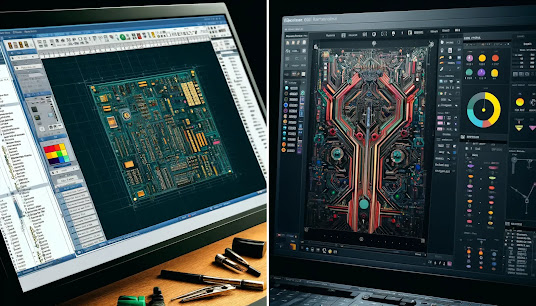Today's PCB designers face the dual challenges of escalating system demands and the push for faster time-to-market. To navigate these challenges, significant trends have emerged in PCB design: Automation, Collaboration, and Simulation. This blog post explores these trends and their implications for the future of PCB design, providing insights into cutting-edge tools and techniques that are shaping this dynamic field.
Automation in PCB Design
Automation in PCB design is revolutionizing the way circuits are conceived, designed, and tested for a complex circuit board design such as ATE Boards, Probe Cards, Load Boards, BIB Boards and so on.... Automated tools leverage algorithms to optimize board layouts, route complex interconnections, and perform intricate checks on designs to ensure compliance with electrical and mechanical specifications. Key areas where automation is making a profound impact include:
Schematic Design Automation: Tools like OrCAD and Altium Designer automate the creation of schematics, reducing the likelihood of human error and ensuring design integrity from the start.
Auto-Routing: Advanced auto-routing features are integral to tools such as Eagle and KiCAD, which significantly reduce the time required to design complex multilayer boards.
Design Rule Checking (DRC): Automated DRC systems rigorously check each aspect of the PCB design against predefined rules, ensuring that the final product is manufacturable without costly revisions.
The adoption of automation not only enhances efficiency but also enables designers to handle increasingly complex designs that would be impractical to manage manually.
Collaboration in PCB Design
As projects become more complex involving multidisciplinary teams, Collaborative PCB Design has become essential. Cloud-based platforms and tools facilitate real-time collaboration among team members dispersed across different geographies. This collaborative approach ensures that all stakeholders, including design engineers, manufacturing teams, and supply chain partners, are aligned, leading to:
- Enhanced Design Accuracy: Shared workspaces and synchronized design environments reduce miscommunications and errors, leading to higher accuracy and fewer revisions.
- Reduced Time to Market: With real-time collaboration, changes can be made quickly and efficiently, significantly cutting down the development cycle.
- Increased Innovation: Collaborative environments foster innovation by integrating diverse expertise and perspectives into the design process.
Tools like Autodesk Fusion 360 and Altium 365 are at the forefront, offering integrated environments where design, testing, and production teams can work seamlessly together.
Simulation in PCB Design
Simulation technologies have grown indispensable in modern PCB design, allowing designers to predict and rectify potential issues early in the design process. By simulating different aspects of the PCB, designers can:
Electromagnetic Compatibility (EMC) Simulation: Tools like Ansys HFSS simulate electromagnetic fields in PCBs, predicting electromagnetic interference and compatibility issues.
Thermal Simulation: Simulations help predict heat build-up and dissipation in circuit boards, which is crucial for high-power or densely packed devices.
Signal Integrity Analysis: High-speed designs often suffer from signal integrity issues; simulation tools can model and analyze signal behavior to mitigate problems like crosstalk and noise.
These simulations are vital for ensuring the reliability and functionality of PCBs in real-world applications.
The Future of PCB Design
Looking ahead, the future of PCB design is poised to be more integrated and intelligent, with advancements in AI and machine learning leading the charge. Predictive design tools, smarter automation, and more robust simulation capabilities will further streamline the design process. Moreover, the integration of IoT and real-time data analytics will enable more dynamic and responsive PCB systems.
Conclusion
The ongoing evolution in PCB design through automation, collaboration, and simulation is equipping designers to meet current and future challenges. As electronic devices continue to grow in complexity and functionality, the tools and techniques at the disposal of PCB designers will not just keep pace but often drive the innovations. Understanding and leveraging these trends is crucial for any PCB designer aiming to remain at the cutting edge of PCB technology.
This exploration not only underscores the importance of embracing new technologies but also highlights the exciting possibilities that lie ahead in the realm of PCB design. As we look to the future, the role of sophisticated design tools and Collaborative Platforms will undoubtedly become more central in transforming ideas into reality, ensuring that the field of PCB design continues to innovate and inspire.











